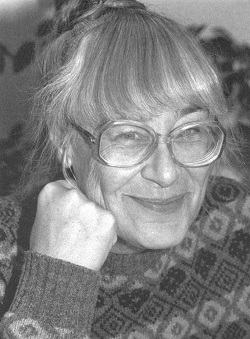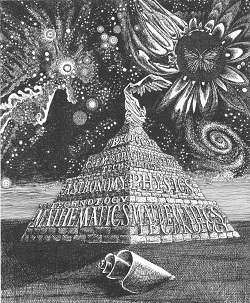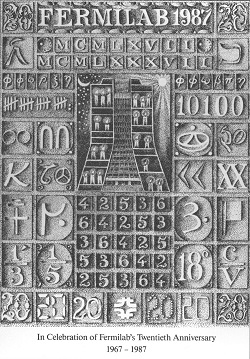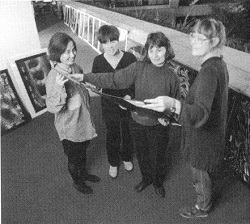Making an Art of Science: High-Energy Artist Says Goodbye
Art and science blend elegantly in the work of Fermilab artist Angela Gonzales, leaving a lasting impact on the Laboratory and all who pass through it. Angela Gonzales retires after 31 years of creating distinctive designs for Fermilab.
From the day she arrived in 1967, Angela Gonzales added to Fermilab's unique character by taking an abstract view of the concrete.
She asked, "Do industrial-style buildings have to be industrial gray in color?" She answered with a palette of blue, orange and yellow (even apple-green, in the early days) that was sure to arouse strong reactions but would never go unnoticed. Included was a row of propane tanks whose colors graduated from orange to yellow.
"They didn't have to be just obvious old gray things," said Nancy Peoples, wife of Fermilab Director John Peoples, who worked closely with Gonzales on art committees at the Lab from 1980 until Gonzales's retirement on July 31.
"Her choice of colors gave the Lab a really unique touch," Peoples continued. "It's such an individual style, and it removes the Lab from having just the usual conglomerate look of mundane plastic or concrete. It gives the Lab a feeling of being in touch with the arts as well as with the sciences."
Both parents were artists, meaning Gonzales was in touch with the arts beginning with her childhood in 1930s Germany. Her father's involvement in modern art, not favored by Hitler, forced the family to move around Europe. Gonzales has remained a committed traveler, visiting her elderly mother annually in Germany, and journeying to wide-flung destinations from Costa Rica to Egypt.
"She once brought me back a bottle of sand from the Sahara Desert," said Hazel Cramer, Gonzales's friend and fellow committee-member through her own 26-year career at the Lab.
Cramer recalled that Gonzales had worked at Cornell with Robert Wilson, the Lab's first director, and rejoined Wilson at Fermilab to work on the design for the site. She noted that in addition to being an accomplished abstract artist, working in a range of media from paint to ink to pencil, Gonzales was skilled at technical illustration and produced distinctive work for both experimenters and theorists. Her designs include the covers for many of the Lab's annual reports, including the commemoration of the Lab's 20th anniversary in 1987.
"She's also a very clever writer, although English is not her native language," Cramer added. "She's very widely-read, and she has a great deal of knowledge in many fields."
Peoples described Gonzales as having a keen eye for art and design, and holding high standards.
"She does not accept anything that she thinks is substandard," Peoples said.
Gonzales offered a blunt statement of those standards as recently as the holiday season of 1997, when the Wilson Hall atrium was decorated with a series of banners adapted from graphic representations of particle collisions.
Not amused, Gonzales wrote to FermiNews and quoted Goethe in giving her judgement: "Den Geschmack kann man nicht am Mittelgut bilden, sondern nur am Allervozueglichsten," which she translated as "(Good) taste cannot be achieved by learning from the mediocre (I add trash; there is not even much 'mediocre' left to go by) but only from the most excellent."
Cramer, who continues to serve on the Lab's Auditorium Committee after retirement, has known Gonzales since 1968, and remembers Gonzales’s daughter as "a four-year-old crawling around on the floor and drawing pictures." But she wryly describes Gonzales as "not a people person."
"Like many artists, she's very involved with what she is doing at the moment," Cramer said. "I met her in 1968. I remember being introduced to her, and I said 'Hello,' and she said 'Hello,' but then she went right on talking (with someone else) as she often does."
"The next day I happened to see her at the Oak Brook shopping center. I said 'Hello' but she didn't say anything. Then she came back five minutes later, tapped me on the shoulder and said, 'I know who you are now. I can say hello.'"
Socializing and friendship were separate categories.
"If she's your friend, she is truly your friend," Cramer said. "She will not tolerate any criticism of a friend, even in a joking way."
After 31 years, Gonzales's work speaks forcefully of her contributions.
"A lot of her work will be around us, but her day-to-day input will be missing," said Peoples. "With her retirement, I think the Lab loses a lot. It's almost like losing some of its original soul."






